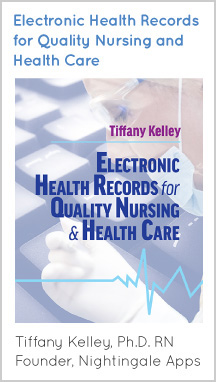I am a nurse, an informaticist, and at times, I am also a patient. Last summer, I made an appointment for a vision exam. I was getting into my car to drive to the office when I noticed I had a voice mail. The voice mail was from the office letting someone else know that her glasses were in and she could come pick them up. I thought, ‘well that is strange, I’ll have to let them know when I get there that they called the wrong number’. What I should have done was call right back. Had I called back, I would have found out that my appointment needed to be rescheduled due to a malfunction with the equipment that day. (Instead, I drove to the office and found out in person). Although, had I called when I got the voicemail, I wouldn’t have identified the informatics challenge I saw upon arrival to the office.
When I arrived, the receptionist told me that she had tried to get in touch with me but they didn’t have my phone number. I found the statement odd considering I just received a voice mail to my phone number, but for another individual! As this conversation continued, I looked down at their appointment book. The appointment book was a binder that contained a piece of paper for each day. Each piece of paper had formatted time slots every 30 minutes. Next to the time slots were blank spaces to write in the patient’s name and phone number in pencil. The number written for me was illegible and missing a digit. The receptionist told me they didn’t know how to reach me and couldn’t explain how they called my number for another patient…. However….it turns out there was a paper chart on the counter (right next to the appointment book) which held my patient information – and my phone number. The office did not appear to have considered to search beyond the appointment book to locate my phone number.
It was during this interaction that my informatics mindset kicked into high gear. I immediately identified several problems with the current process observed over the last minute or two: paper records, pencils, illegible handwriting, multiple documents with the same information, poor communication between staff, and what appeared to be suboptimal critical thinking. This example represents a system or organizational level failure (See IOM’s To Err is Human for further info).
Here are some initial thoughts that you may think of in relation to why this occurred:
1) The office is using paper records instead of electronic records
2) The receptionist failed to look in both places for the information
3) The individual that wrote the number down illegible should have written it more clearly
The first reason is a system or organization level issue. The second and third reasons place responsibility on an individual rather than a system or organization. When I see problems like this, I often want to look to understand and solve them at a system level. To do so often requires some process oriented changes to support the individuals in their delivery of care.
Yes, the office is using paper records. As the nation moves toward nationwide EHR adoption, an important factor to note is that the solution (paper or electronic) must be supported by the processes of care delivery. Just having an EHR in place is not enough. There must be processes for how each role group will use the EHR to exchange information needed for care. Aside from not using an EHR, the risk wasn’t the piece of paper itself, but rather how the paper was used to support the receptionist’s information needed to contact patients. The pencil facilitates storing of patient information but has its faults…the largest fault is that one can erase information. At a broader level, I saw the three bigger challenges as having multiple documents for the same information (e.g. name and phone number), poor communication between staff members (e.g., neither individual knew how they called the wrong number) and the suboptimal critical thinking (e.g., asking if there might be another place where a patient’s phone number might be stored).
I’ve described this brief situation in detail to provide some insight into the challenges faced in health care today in order to manage patient information in a safe, effective, and efficient way. The situation I described required an hour of my time with no end result other than a rescheduled appointment. In the big picture, this didn’t affect my health or result in a negative outcome. Instead, this offered me an exemplar to demonstrate the importance of understanding processes of care delivery from a system level. As we continue to require more safety and efficiency in the care we deliver, we need to have the detailed knowledge of how care is delivered in an organization to identify solutions that will improve the quality of care.


